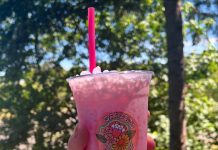Submitted by Saint Martin’s University
LACEY, Wash. – Years before Dr. Heng Li became a medical doctor and Traditional Chinese Medicine physician, he initially had some doubts about TCM.
“I did not like TCM, in the beginning. I once thought it was witch doctor’s stuff,” says Li, who recently arrived from the Shanghai University of Traditional Chinese Medicine (SHUTCM) to spend five weeks as a visiting professor at Saint Martin’s University.
“I have an uncle, a top authority on acupuncture in China, who warned me, ‘One day, you’re going to fall in love with Traditional Chinese Medicine.’ And I did!” recalls Li, a fifth-generation TCM physician within his family.
Li is assistant director and associate professor at Shanghai University’s China Shanghai International Acupuncture and Moxibustion Training Center. He is also chief doctor in the Acupuncture and Tuina Department of the Municipal Clinic Hua Dong Hospital. Li is sharing his knowledge and passion for Traditional Chinese Medicine, a 2,000-year old discipline, with students enrolled in the Saint Martin’s RN-to-BSN Nursing Program’s introductory course, Traditional Chinese Medicine and Evidence-Based Practice.
Li’s visit to Saint Martin’s is the result of the sister university relationship the two schools have shared since 2008. Students at SHUTCM are typically sent to Saint Martin’s for summer cultural exchange activities, and Li is the second visiting professor from SHUTCM to arrive on the Lacey campus.
“It is a great honor to have Dr. Li with us. This is a culmination of years of cultural and academic exchange between the two institutions,” said Josephine Yung, vice president of the Office of International Programs and Development at Saint Martin’s.
“Dr. Li provides students with the insight, experience, and wisdom of a traditional Chinese medicine doctor (TCM) who uses an approach to health that is multifaceted and able to help individuals achieve wellness,” says Louise Kaplan, director of the RN-to-BSN program. “He is skilled at making complicated theories understandable and brings to life the power of TCM.”
For Li, his stint as a guest lecturer is all part of his main mission: to spread accurate information and knowledge about Traditional Chinese Medicine to the Western world, and to more fully integrate TCM with Western medicine. Today, Traditional Chinese Medicine is practiced alongside Western medicine in clinics and hospitals throughout China, and TCM has become a very common practice in the United States.
Still, Westerners continue to hold numerous misconceptions about TCM. Li attributes those misunderstandings, in part, to what he describes as the “Americanization and Europeanization” of the TCM approach.
“In China,” Li further explains, “Traditional Chinese Medicine doctors are also M.D.s, medical doctors. We first treat a patient just like an M.D. would. Then, following a consultation and an examination, we use Traditional Chinese Medicine to treat their problem.” In the West, many TCM practitioners are not medical doctors, and TCM is not considered to be part of conventional medicine but, rather, alternative and complementary medicine.
TCM practices include Tuina (pronounced “twee nah”), a type of body massage, acupuncture, herbal therapy, dietary therapy, cupping (applying a heated cup to the skin), moxibustion (burning and applying a raw herb in conjunction with acupuncture), and Tai Ji and Qi Gong mind-body therapies.
One significant difference between the two medical approaches, Li says, is TCM is a more holistic-based medicine than Western medicine. “We not only treat the body, but also the mind and the soul.”
Another important difference, according to Li, is Traditional Chinese Medicine places extensive emphasis on individualized treatment. “Just like no two leaves of a tree are exactly alike, the same is true of human beings,” Li says. “We consult with each patient, look at them, examine them, gauge their constitution. In Western medicine, however, the treatment is not so much individualized as it is uniform. For example, the common cold is treated exactly the same in all individuals.”
Li believes this emphasis on the individual makes for a “perfect match” between Traditional Chinese Medicine and nursing. “TCM can be transplanted very well into a nursing program because we share that same core value of individualized attention.”
“Nurses are with their patients all the time, more than the doctors. Nurses have a great opportunity to observe a patient as an individual person, as we do in Traditional Chinese Medicine.” Along with nursing students, other students enrolled in the introductory course who are considering careers in the health professions will be learning about TCM from Li.
In addition to serving as a guest lecturer, Li is assisting Saint Martin’s in planning an exhibit about Traditional Chinese Medicine the two universities are cosponsoring and which is scheduled to be held July 18-20 on the Saint Martin’s campus and within the surrounding community.
Saint Martin’s University is an independent four-year, coeducational university located on a wooded campus of more than 300 acres in Lacey, Washington. Established in 1895 by the Catholic Order of Saint Benedict, the University is one of 14 Benedictine colleges and universities in the United States and Canada, and the only one west of the Rocky Mountains. Saint Martin’s University prepares students for successful lives through its 23 majors and seven graduate programs spanning the liberal arts, business, education, nursing and engineering. Saint Martin’s welcomes more than 1,100 undergraduate students and 400 graduate students from many ethnic and religious backgrounds to its Lacey campus, and 300 more undergraduate students to its extension campuses located at Joint Base Lewis-McChord and Centralia College. Visit the Saint Martin’s University website at www.stmartin.edu.



















































